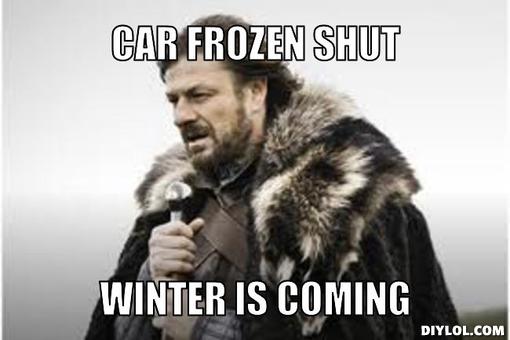This might seem like a no-brainer, but it’s still one to be
aware of. It’s obvious that if you can’t see, you can’t drive, but sometimes
fog can seem to appear out of nowhere. Most fog occurs when there is a
difference between the ground and air temperature, causing the humidity to
condense into fog. The tough part about this driving hazard is that often times
it can be patchy and dense, going from 1-mile visibility to zero in a matter of
seconds. Dense fog is a major contributor to many multi-car accidents on the
highway. If you drive into near-zero visibility fog, pull over or get off
the highway. While you may be driving cautiously, someone behind you may not be
as smart.
3. Snow.
Again, while this might seem straightforward,
there are hidden dangers of snowfall that one might not realize while driving
on the road. The obvious problems are visibility and tire traction. In short,
if you know you’re going to be driving in heavy snow, wait it out, and leave
later. However, during heavy snow bursts like ones that occur in lake effect
snow bands can drop snow at 4”+ an hour. Even if you travel slowly, snow like
this can melt when it hits your warm windshield (if you’re using a heater), and
partially refreeze, forming chunks of ice that can clog up your wipers. Rush
hour is the most likely time for this to happen.
4. High Wind.
While many cars can handle a little bit of wind,
driving in the mountains on a windy day or along the coastline during a winter
storm can cause some serious problems. If you’re driving in a high-profile
vehicle such as a van, box truck or even an 18-wheeler, the wind has more to
push on, and therefore more room to knock you around. Before heading out, check
the weather in a few locations along your route to make sure the wind isn’t
stronger in certain areas, especially if you look to make elevation changes on
your way.
5. Black Ice.
While the result can be similar to driving in
freezing rain, the way this kind of driving hazard is formed
differently. Any time there is water on the ground, if the temperatures
dips to at or below freezing, it can form black ice, which is called that since
it looks like there’s nothing but pavement. Black ice can be tough to detect.
If you head out in the morning after a day or rain or snowmelt, be wary and
drive carefully to avoid hitting a patch of this stuff on your drive to work.
It could really ruin your day.
6. Other Drivers on the Road.
I know, kind of a cop out for the last one, but I think this
might actually be the most dangerous element of them all during the winter
weather season. Even if you’re cautious and driving safely during inclement
weather, the odds are good that someone driving near you is not paying
attention to any of those rules. 24% of all traffic accidents are attributed to
weather, and it’s almost always one person’s fault. By sharply braking on slick
roads, tailgating, or not having the proper winter tires, other drivers can be
a huge danger to you.
So remember, winter is coming, and in some instances, it’s
already here. So be sure to take an extra look at the weather forecast,
drive with caution, and be aware of aggressive drivers during this already
tough winter season. If you think there are other bad winter conditions that I
didn’t mention, please note them in the comments.
MechanicAdvisor.com is one
of the largest online mechanic resources in the US. We are the premier website
for consumers to research and connect with reputable local mechanics for
routine and specialty automotive repair. Our website features instructional videos,
articles about maintaining your car, and detailed profiles of over 500,000
mechanics across the country. If you're a shop owner, please claim your shop page for free
here.

